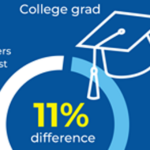It’s not necessarily stubborn, lazy teachers keeping new ideas and methods from taking hold in a school. Sometimes it’s the flawed policies and unrelenting rigidity of the system itself.
A few years ago, I had the chance to visit a 2nd-grade classroom as part of an observation period for vertical collaboration. As I sat taking notes, I noticed a boy zipping through his math problems. When he was finished, he hunched over his backpack and zipped it up as carefully as he could. He looked both ways and smiled. I knew the look. It was the expression of a kid who is about to sneak candy.
However, he didn’t pull out a bag of candy. Instead, he slid a book about the “30 grossest facts about pirates” under his math packet. He grabbed the supply bucket from the middle of the table and began building a small fort around the book. Then, with his left hand, he turned the pages while he scribbled lines with his right hand. It struck me as odd that he wasn’t sneaking candy. He was sneaking learning. To him, though, there was little difference. This was the book he had hand-chosen from the library on a topic that he, no doubt, found as exciting as candy.

“Javier, what are you supposed to be doing?”
“Math,” he answered.
“And what are you doing?”
“Reading.”
“I need you to pull a card,” the teacher said.
“But I’m done with math,” he protested.
“This is math time,” she said. “If you need more work, I’ll give you more work. Next time it happens, it’s a lunch detention.”
Later, as they walked out to recess, I asked him if he learned a lesson. He nodded. “I learned that if you finish your work too fast, you get more work.”
The next day, I pulled the teacher aside and related the story. Instead of getting defensive, her answer surprised me.
“I wish I could let him read when he’s done,” she said.
“Is he behind in math?”
She shook her head. “No, he’s doing just fine. I actually gave him some harder problems.”
“Then why can’t he read when he’s finished?”
“We have to provide structured, subject-related enrichment.”
“Can’t reading be enrichment?”
She shook her head. “If the state comes by to do an audit, they need to see that all children are getting the necessary minutes for math. I would love for kids to read more often. Do you know how exciting it is as a teacher to see a kid fall in love with informational text?”
“OK, if he has to do math the whole time, what about having him develop his own problems? Maybe he could model processes. You could increase student discourse. You have four computers. What if he blogged about the way this math applies to a real-world context?”
She shook her head. “We have to teach this way. They won’t have models and manipulatives and computers on the test. They won’t get to compare processes with their neighbors.”
I asked her how she would teach if nobody were watching. She described independent projects, hands-on science experiments, field trips, and silent reading based upon student choice. She had ideas of what great learning should be, but she felt hamstrung by policies that kept her in an industrial model of education.
PD not always the issue
When I first walked into that teacher’s classroom, I assumed that she just needed some professional development.
When the professional development fails to change classroom practices, the response is often to re-teach the strategies.
Our school district allocates hundreds of thousands of dollars for professional development every year. The assumption is often that change is failing to occur because the professional development is poorly presented or doesn’t apply to what teachers are doing. As a result, many districts are changing their approach to professional development. In my district, I am noticing an increase in coaches who embrace a cycle of modeling, observing, and guiding teachers through reflective conversations and goal setting. The idea is to provide more feedback to teachers so they can adjust their practices based on what they have learned. In many cases, we are using data to drive the professional development selection, implementation, and assessment.
Despite these changes, very few of these practices are happening in many schools. After multiple trainings on student discourse and problem solving in math, many teachers still hand out packets that are closely aligned to the benchmark tests. After learning about front-loading vocabulary and using sentence stems to help English language learners, teachers still don’t adapt them.
When the professional development fails to change classroom practices, the response is often to reteach the strategies. Sometimes it means adding more coaches to help model the processes in an authentic context. Still other times, it has meant hiring outside consultants and adding more training opportunities after school.
It’s easy to write this off as teacher laziness.
It might also seem that teachers are simply being stubborn. However, in many cases, these are hard-working, humble teachers who want to implement new strategies but are afraid to take the first steps because of flawed policies.
Often there is a huge chasm between the professional development that teachers experience and the policies that govern their practice.
It’s the policies
Often, there is a huge chasm between the professional development that teachers experience and the policies that govern their practice. A few years ago, I completed a 40-hour gifted training on project-based learning, student choice, inquiry, and authentic assessments, only to face a rigid curriculum map and weekly standardized tests.
Similarly, teachers have been encouraged to include student collaboration, discourse, and problem solving in math, and then student and teacher performance has been judged based upon isolated, standardized, computation-driven math tests. Instead of pursuing innovation, teachers become risk-averse learning managers, reluctant to do anything that might reduce test scores and thus ruin their value-added scores.
Often teachers know great strategies and have even made paradigm shifts toward a constructivist style. However, policies haven’t changed to give teachers the permission to do what’s best. If anything, policies are growing more rigid, and teachers are being asked to use scripted curriculum and programmed learning systems.
Subversive sages
This year, I am teaching an untested elective class, and I have the freedom to organize thematic, project-based units that include student input in the planning phase. I can use authentic assessments, such as conferencing, blogging reflections, and portfolios. I am no different in my knowledge or in the paradigms. However, a looser set of policies means I get a chance to do what’s right without worrying that I will get in trouble.
Find a loophole in bad policies so you can sneak in good instruction.
Last year, I felt subversive, like I was quietly hacking a system of rigid, standardized tests. I had to fit project-based learning into the structures of a week-by-week, isolated curriculum map. I had to fit student inquiry into a rigid lesson plan format that required every lesson to progress from direct instruction to guided practice to independent practice, without ever changing the order.
I learned, however, that the best way to deal with bad policies was to be a subversive sage. If I could prove that it worked, I could continue to teach in a constructivist style. I learned to use the language of the system. So, a moment of guided inquiry became direct instruction. A debate on the meaning of an idea became vocabulary front-loading. I could teach standards together but only emphasize the current standard from the curriculum map.
Ultimately, it wore me out. The constant sense that I was breaking the rules is why I wanted to be in a space with fewer rules. Teachers shouldn’t have to be rebels. We shouldn’t have to feel like we are hacking a system to do what’s right. However, until policies change, it’s often the only solution. I would love to see schools become spaces of permission, where authenticity and innovation are the norm. Until then, though, sometimes the only option available is to find a loophole in bad policies so that we can sneak in good instruction.
Citation: Spencer, J.T. (2014). In practice | Teaching: PD isn’t the problem. Phi Delta Kappan, 95 (7), 74-75.










